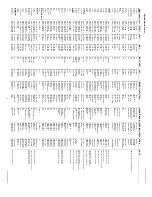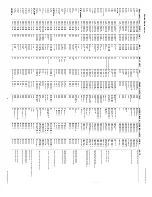
3
v5.3 (2126)
© 2005 Directed Electronics, Inc.
awg) wire to the car’s tach wire under the hood (normally the nega-
tive side of the coil or tach output of coil pack). After you have
connected the GREEN wire, you need to teach the remote starter the
vehicle’s tach rate at idle. Proceed to step 12A.
Note:
You must have already initialized the remote starter in Step 11.
12A. Tach Rate Learning
Note:
Only use if the tachometer sensing method is chosen.
A.
Connect the GREEN wire to the car’s tach wire under the hood.
B.
Turn the On/Off control switch to the “OFF” position. Wait 5 sec-
onds for the red LED light flashes to stop.
C.
Program the unit to the tach mode by pushing the White “op-
tion” button once and watching the red LED light flash. Now
push the middle button on the transmitter for a second until you
see the red LED light flash again. You are now in TACH mode. (If
the LED light flashed twice or sometimes three times – simply
push the transmitter button again until you get only one flash).
D. Wait 5 seconds for the red LED light to flash 3 times.
E.
Turn the On/Off control switch back to the “ON” position
F.
Start the car with the key and let it get to a
normal idle. Do not
press on the gas pedal.
G. Push the red “code learn” button for a second.
H. Watch the red LED light. It will come on after 3 or 4 seconds,
indicating that the idle rate has been learned.
I.
Watch the LED light stay on steady as the vehicle is running and
goes off as you rev the rpms above twice the idle rate. The LED
light must go out when you rev it above twice the idle rate to
confirm correct tach learning.
J.
Turn the key to the “Lock/Off” position. You are now finished.
K.
Turn the On/Off control switch off and the red LED light will go
out.
Note:
Once these steps are complete – you cannot use the red LED
light to confirm the tach idle rate again. You can however repeat the
above steps to learn tach over again at any time.
OPTIONAL STEPS
13. Yellow Wire - Headlights/Parking Lights - Control Harness
Connection of the YELLOW wire allows you to activate the low beam
headlights or parking lights to show the vehicle has remotely started.
After the remote starter has started the car, the lights will remain on
until the remote starter shuts off after 10 minutes, or when the brake
pedal is pushed, or when vehicle car is put into gear.
This is a relay
+12 Volts output.
Connect the YELLOW wire to the wire that has
power when the lights are on. You do not need to add a relay unless
your vehicle has a negative lighting system.
14. Blue - Horn/Siren - Single Small Blue Wire
The BLUE wire, which is optional, signals the horn to honk once each time
the remote starter starts the vehicle. Connect the blue wire to the factory
horn wire, which is often found running down the steering column. It will
normally show +12 Volts at rest and the voltage will disappear when the
horn is honked.
This is a 400 mA transistor ground output. If your vehicle's
horn requires a positive input, you will need a relay.
15. Brown/White - Alarm Disable - Control Harness
The BROWN/WHITE wire, which is optional, is
Alarm Disable
, which
will give out a quick negative pulse just before starting the ve-
hicle. This wire can be used to turn off the factory alarm system in
vehicles which have them. In most vehicles, this wire is located in
the driver’s kick panel. A relay is needed for vehicles which require a
positive pulse.
you may share the wiring – but be sure to diode isolate each wire
going to the hood pin switch with the bands of diodes pointing
towards the pin switch as shown.
10. Orange Wire - Brake Shut-off - Control Harness
Connect the ORANGE wire to the brake wire which re12 Volts
when the brake pedal is depressed.
This wire must be connected.
It
arms a critical safety feature which disables the remote starter when
the brake pedal is depressed.
Note:
In some cars, the ignition must be in the “on” position to test
the power in the brake wire.
Note:
If the Ignition 1 & Ignition 2 wires come on whenever the brake is
depressed and the hood is open this just means you need to initialize
the unit in Step 11.
11. Initializing the Remote Starter
BEFORE UNIT WILL DO ANYTHING FOR THE FIRST TIME, YOU MUST
INITIALIZE THE REMOTE STARTER
A.
Insert the fuse into the pink fuse holder on the pink power wire.
B.
Turn the control switch on.
C.
The remote starter requires the installer to open the hood and
then press and hold the brake pedal. Note: The ignition/dash lights
will come on if the unit is not initialized.
D. While depressing the brake (with the engine off and the hood
open) turn the ignition key to the “RUN” (not “start”) position.
E.
Put the car in “DRIVE” from the “PARK” position.
F.
Put the car back in “PARK” and release the brake.
G. Turn the key off and remove the key.
Note:
Confirm initialization by turning the ON/OFF control switch “OFF”
and then “ON”. The red LED light on the remote start module will
flash once immediately as the switch is flipped from the “OFF” to the
“ON” position.
If the unit is not initialized then the dash lights will come on (the
remote starter powers up the ignition wires) when the brake is de-
pressed or the hood is open, and the control/valet switch is on. RE-
PEAT STEPS A THROUGH G. See the colored Trouble Shooting Sheets
if necessary.
12. Green Wire - Tach Input - Control Harness
The remote starter has two ways of monitoring the car during the
starting process. Both ways will ensure a clean, accurate start. Read
about both methods before deciding which one to use. Normally you
should try the “
No Tach
™
” method first.
“No Tach™” Starting
This starting method does not require the connection of the GREEN
tach wire. This method will start the car by reading the car’s voltage
before attempting to start, and then looking for a voltage increase
when the alternator kicks in. This feature automatically takes into
account voltage, temperature, and the time since the vehicle was last
run. The “No-Tach™
”””””
starting is preset at the factory and you can
skip step 12A if you would like to use it. Note that if the vehicle is
hard to start, set option 3 (Setting Program Features section (step
20)) for “extended crank.”
Tachometer sensing
If the vehicle is generally hard to start (i.e. requiring a cranking time
of more than 1 second) you will get more accurate starting with the
tachometer sensing starting method. This method starts the car by
reading the engine speed (tach) information from a wire under the
hood. If you choose tachometer sensing, connect the GREEN (18




































